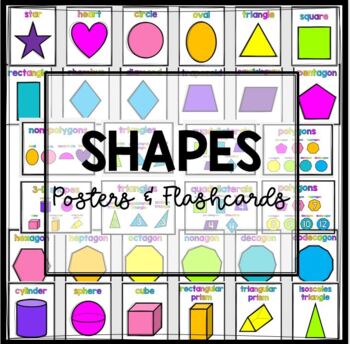2D and 3D Shapes Posters, Mini Posters, and Flashcards - Colorful Cute
The Mello Teacher
110 Followers
Grade Levels
Not Grade Specific
Subjects
Resource Type
Standards
CCSSK.G.A.1
CCSSK.G.A.2
CCSSK.G.A.3
CCSSK.G.B.4
CCSSK.G.B.5
Formats Included
- PDF
Pages
40 pages
The Mello Teacher
110 Followers
Also included in
- These 81 visual math posters and flashcards are perfect to brighten up your primary classroom. Math posters can be displayed to support student learning and flashcards to reinforce what was learned. Save $1.50 by purchasing the bundle.Price $8.00Original Price $9.50Save $1.50
Description
In this product you will find individual shape posters for every grade level (k-5), as well as matching flashcards for practice, and mini posters to easily display or share with students for them to reference.
Included in this set are the shapes:
-star
-heart
-circle
-oval
-triangle
-isosceles triangle
-scalene triangle
-equilateral triangle
-square
-rectangle
-rhombus
-diamond
-trapezoid
-parallelogram
-pentagon
-hexagon
-pentagon
-heptagon
-octagon
-nonagon
-decagon
-dodecagon
-cylinder
-sphere
-cube
-rectangular prism
-triangular prism
Flashcards for all shapes
Mini Posters:
- non-polygons
- triangles (x2)
- quadrilaterals (x2)
- polygons (x2)
Total Pages
40 pages
Answer Key
N/A
Teaching Duration
N/A
Report this resource to TPT
Reported resources will be reviewed by our team. Report this resource to let us know if this resource violates TPT’s content guidelines.
Standards
to see state-specific standards (only available in the US).
CCSSK.G.A.1
Describe objects in the environment using names of shapes, and describe the relative positions of these objects using terms such as above, below, beside, in front of, behind, and next to.
CCSSK.G.A.2
Correctly name shapes regardless of their orientations or overall size.
CCSSK.G.A.3
Identify shapes as two-dimensional (lying in a plane, “flat”) or three-dimensional (“solid”).
CCSSK.G.B.4
Analyze and compare two- and three-dimensional shapes, in different sizes and orientations, using informal language to describe their similarities, differences, parts (e.g., number of sides and vertices/“corners”) and other attributes (e.g., having sides of equal length).
CCSSK.G.B.5
Model shapes in the world by building shapes from components (e.g., sticks and clay balls) and drawing shapes.






